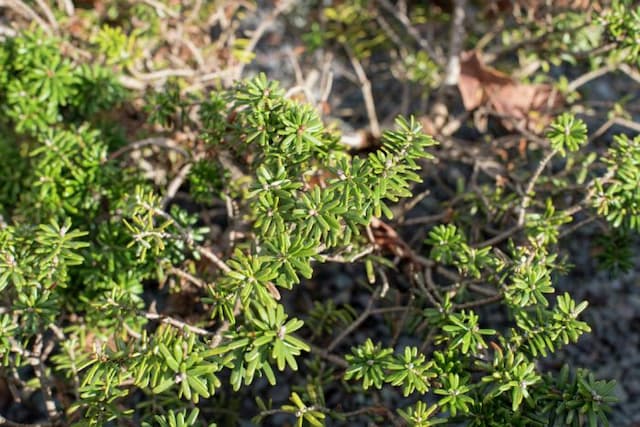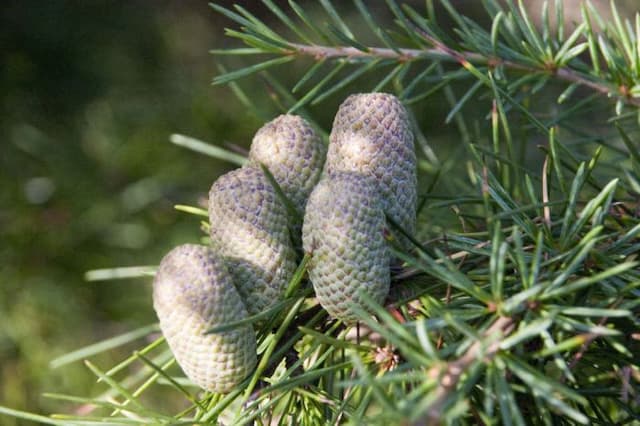Cedar of Lebanon Cedrus libani

ABOUT
The Cedar of Lebanon is a majestic evergreen conifer that is well known for its beauty and historical significance. This plant has a grand, spreading crown with horizontal branches that often give it a flat-topped appearance. In its youth, it tends to have a more conical shape, which becomes wider and more umbrella-like with age. Its needles are a dark green color, which can sometimes appear almost blue-green, and they are arranged in clusters on short spur-like shoots. These needles are stiff and pointy, measuring roughly 1 to 1.5 inches in length. The foliage provides a dense, lush coverage, offering a stark contrast against the rugged, often gnarly branches. The bark of the Cedar of Lebanon is dark grey, and it develops deep fissures and cracks as the plant matures, giving it a very textured and rugged appearance. Younger trees have smoother bark, which becomes more furrowed over time. The plant produces large, barrel-shaped cones that stand upright on the branches. These cones can take up to a year to mature, and they typically have a wooden appearance, with a color ranging from green when young to a brownish-grey as they age. Overall, the Cedar of Lebanon has a dignified and stately presence, with its impressive canopy and strong, durable wood that has been prized for construction and various cultural practices for millennia.
About this plant
 Names
NamesFamily
Pinaceae
Synonyms
Cedar Of Lebanon, Lebanese Cedar
Common names
Cedrus libani subsp. libani, Cedrus libanotica, Cedrus libanotica var. brevifolia, Cedrus libanotica var. libanotica.
 Characteristics
CharacteristicsLife cycle
Perennials
Foliage type
Evergreen
Color of leaves
Green
Height
40 feet (12 meters)
Spread
30 feet (9 meters)
Plant type
Tree
Hardiness zones
6
Native area
Mediterranean
Benefits
 General Benefits
General Benefits- Landscape Aesthetics: Cedrus libani, commonly known as Cedar of Lebanon, adds majestic beauty to landscapes with its dense, pyramidal to conical shape and spreading branches.
- Shade Provider: With its wide canopy, it offers a significant amount of shade, making it ideal for large gardens and parks.
- Wood Production: Cedar of Lebanon is valued for its high-quality timber, which is durable, aromatic, and resistant to decay; used in construction, furniture, and crafts.
- Wildlife Habitat: Its foliage provides shelter for birds and other wildlife, while the cones serve as a food source for various species.
- Erosion Control: Its robust root system makes it effective in stabilizing soil and preventing erosion on slopes.
- Cultural Symbolism: Holds significant historical and cultural importance, being mentioned in various religious texts and symbolizing strength and resilience.
 Medical Properties
Medical Properties- Antiseptic: Cedar oil, which can be derived from Cedrus libani, has been known for its antiseptic properties and is used topically for minor wounds.
- Anti-inflammatory: The oil may also act as an anti-inflammatory agent when used in traditional medicinal preparations.
- Diuretic: In historical medicinal practices, parts of the cedar tree were used for their diuretic effects to help with the removal of excess fluid from the body.
- Expectorant: Cedar has been used traditionally to help with respiratory conditions, as it is believed to help clear mucus from the airways.
- Sedative: Cedrus libani is sometimes utilized in aromatherapy for its potential sedative and calming effects on the mind.
 Air-purifying Qualities
Air-purifying QualitiesThis plant is not specifically known for air purifying qualities.
 Other Uses
Other Uses- Cedarwood oil, extracted from Cedrus libani, is often used as a fragrance component in perfumes and soaps due to its distinctive, warm woody scent.
- The sawdust and shavings of the cedar can be used as bedding for small animals, providing a natural repellent for fleas and other insects.
- Cedar wood, being resistant to decay, is popular for constructing outdoor furniture and structures like gazebos and fences.
- The aromatic wood from Cedrus libani is sometimes used in its native regions for smoking food, imparting a unique flavor to meats and cheeses.
- In traditional woodworking, the wood of the cedar is carved into intricate boxes, ornaments, and religious icons, especially in Middle Eastern crafts.
- Cedrus libani wood chips can be pressed into particle board or fiberboard, offering a sustainable material for construction and furniture making.
- Cedar cones, containing seeds, can be used as a natural mulch for gardens, providing nutrients as they break down and deterring pests.
- The resin of the cedar tree has been utilized historically in waterproofing and as an adhesive in the construction of boats and buildings.
- Cedar branches and foliage can serve as natural decoration during holidays, especially as Christmas trees in western cultures.
- Wood from the cedar can be turned into musical instruments, like the oud, a lute-type instrument prominent in Middle Eastern music.
Interesting Facts
 Feng Shui
Feng ShuiThe Cedar of Lebanon is not used in Feng Shui practice.
 Zodiac Sign Compitability
Zodiac Sign CompitabilityThe Cedar of Lebanon is not used in astrology practice.
 Plant Symbolism
Plant Symbolism- Strength and Endurance: Cedrus libani, commonly known as the Cedar of Lebanon, symbolizes strength and endurance due to its ability to grow in harsh mountainous environments and live for a very long time.
- Eternal life: The Cedar of Lebanon has been revered since ancient times for its long lifespan, often associated with the divine and seen as a symbol of eternal life.
- Purity: Its fragrant wood and its resistance to decay and insects lend it as a symbol of purity and incorruptibility.
- Spiritual growth and healing: The cedar is often considered a spiritual symbol, representing growth, healing, and protection.
- Nobility and beauty: With its majestic appearance and towering height, the Cedar of Lebanon is also symbolic of nobility and beauty.
 Water
WaterThe Cedar of Lebanon requires moderate watering, particularly more during the hot and dry months. Young trees should be watered deeply every two weeks, ensuring that the soil is moist but not waterlogged. Adult trees are more drought-tolerant and may only need additional watering during prolonged dry spells. It is best to provide roughly 1-2 gallons per square foot of root spread to maintain consistent soil moisture levels. Reduce watering frequency as the plant matures, as excessive water can lead to root rot.
 Light
LightThe Cedar of Lebanon thrives best in full sun with ample exposure. It prefers a spot where it can receive at least six hours of direct sunlight daily. Avoid planting it in shaded or partially shaded areas as this will affect its growth and health, as it needs full sun for proper development and to maintain its classic shape.
 Temperature
TemperatureThe Cedar of Lebanon is tolerant of a wide range of temperatures but prefers a temperate climate. It can survive minimum temperatures down to around 20 degrees Fahrenheit and up to 90 degrees Fahrenheit without damage. Ideally, the Cedar of Lebanon performs best when temperatures remain between 60-75 degrees Fahrenheit, providing optimal conditions for growth.
 Pruning
PruningPrune the Cedar of Lebanon to remove broken or damaged branches, shape the tree for aesthetic purposes, and prevent disease. The best time for pruning is during the late winter or early spring before new growth starts. Typically, minimal pruning is needed, but it's important to ensure that any cuts are clean to facilitate quick healing.
 Cleaning
CleaningNot needed
 Soil
SoilThe best soil mix for Cedar of Lebanon is well-draining with a mix of loam, sand, and compost. The ideal soil pH should range between 6.0 and 7.5 to ensure healthy growth and nutrient uptake.
 Repotting
RepottingCedar of Lebanon, being a large tree, does not typically require repotting. It is best to plant it in the ground where it has space to grow.
 Humidity & Misting
Humidity & MistingCedar of Lebanon prefers moderate to high humidity levels but is adaptable to a wide range of conditions.
 Suitable locations
Suitable locationsIndoor
Not suitable for indoor cultivation; requires large space.
Outdoor
Plant in full sun, well-draining soil, and shelter from strong winds.
Hardiness zone
6-9 USDA
 Life cycle
Life cycleThe life cycle of the Cedar of Lebanon (Cedrus libani) begins with seed germination, following stratification which breaks seed dormancy. The seedling then develops a root system and a shoot that will turn into the trunk as it grows. In its juvenile stage, the Cedar of Lebanon starts to develop its characteristic conical shape, which becomes more widespread and flat-topped with age. After reaching maturity, which can take several decades, the tree starts to produce cones; male cones release pollen, while female cones, upon fertilization, develop into seed-bearing structures. Mature trees can live for hundreds of years, continuously growing and reproducing, with older specimens showing massive trunks and wide-reaching branches. Eventually, when the tree dies, it decomposes and recycles nutrients back into the soil, potentially providing a substrate for new Cedar of Lebanon seedlings.
 Propogation
PropogationPropogation time
Spring to Summer
The most popular method of propagating the Cedar of Lebanon is through seed propagation. Stratification is commonly needed which involves a cold moist period to break seed dormancy, typically achieved by mixing seeds with slightly moist sand and storing them in a refrigerator for about one to three months. After stratification, the seeds are sown in a well-draining soil mix, typically during the fall or winter. They should be scattered sparingly on the soil surface and lightly covered with soil. Seedlings require good light but not direct sunlight, and the soil should be kept moist but not soggy to encourage germination. Once seedlings are large enough to handle, they can be transplanted into individual pots to grow on until they are strong enough to be planted in their permanent positions outdoors.









